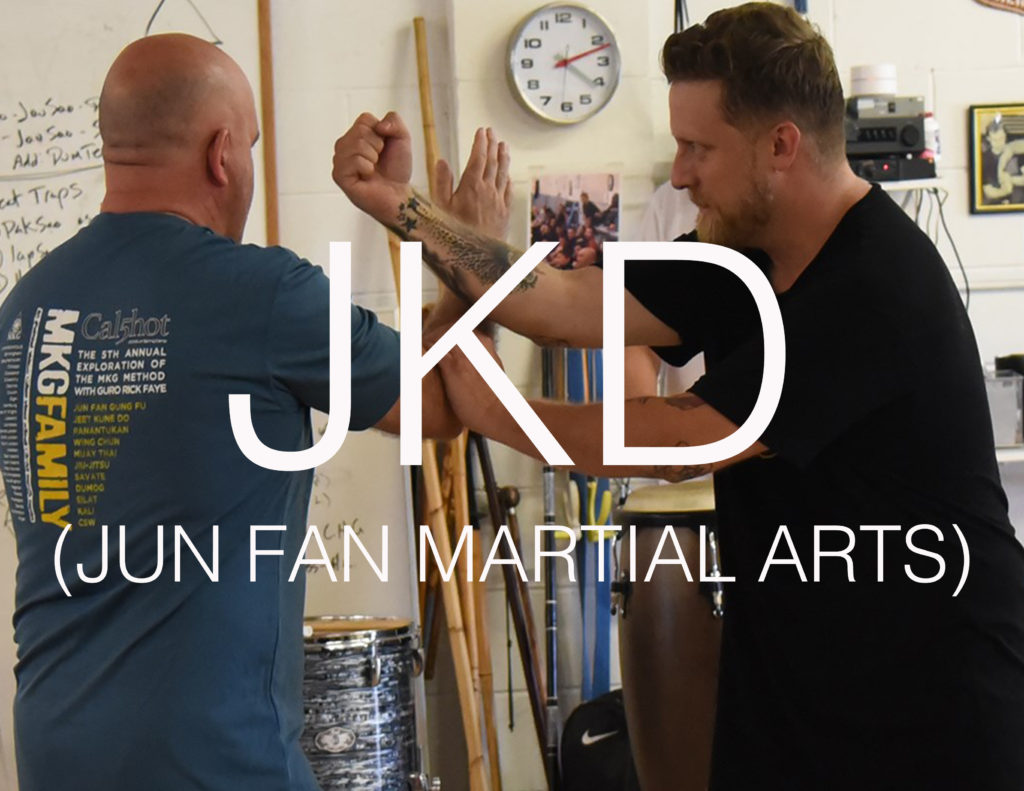
Jeet Kune Do
(The Philosophy That Revolutionized Martial Arts)
Bruce Lee electrified and transformed the martial arts world in the late 1960s and early 1970s. Putting aside the exclusivity and rigid dogmas of traditional arts, he (along with his training partner Dan Inosanto) combined twenty-six elemental arts into a single system that teaches students how to adapt to different fighting styles and encourages personal development. The Jeet Kune Do approach to martial arts shapes everything we do at the Minnesota Kali Group.
What to Expect During Class
JKD classes at the Minnesota Kali Group are high energy, intellectually stimulating and filled with a sense of camaraderie. During class you will learn a variety of kickboxing skills, practicing both on focus mitts and on the body. You will get a great workout every class and quickly notice improvements in your speed, distancing, agility and economy of motion. Geared more toward “the street” than competition, JKD is an excellent self-defense tool.
You will also practice sophisticated trapping, locking and infighting drills. Trapping bridges the gap between boxing and grappling where you will learn to strike at close range while pinning your opponent’s arms. Trapping is fast-paced, complex and a lot of fun once you learn the basics. The various sensitivity drills we work during class will help you to develop the contact reflex necessary to becoming effective in trapping range.
To give a better visual on this, here’s a great video of our Grandmaster Guro Dan Inosanto teaching the MMA legend Anderson Silva some JKD Combinations. These exact same drills show up in class!
A Little Background
Jeet Kune Do is both is both a martial art and a philosophy. Roughly speaking, Jun Fan Martial Arts—which is what we practice in class—is the system Bruce Lee created based on Jeet Kune Do concepts. The truth is slightly more complicated, however, as the two were developed simultaneously, one informing the other as the art evolved.
Departing from the exclusive, form-based training that was common during his time, Bruce Lee created an approach to martial arts that encouraged each student to freely express their unique attributes and abilities. The guiding principle of this revolutionary art is personal growth through continued research and development.
Bruce Lee did this to an incredible degree, incorporating elements of Wing Chun, Praying Mantis, Western boxing, Jiu Jitsu, Judo, fencing and many more into his practice. Along with his pioneering uses of training equipment and his ingenious training methods, he established a completely new and indispensable system of martial arts.
Bruce Lee’s approach to martial arts, however, went much further than styles and systems. His thoughts about training were deeply philosophical.
“If you follow the classical pattern, you are understanding the routine, the tradition, the shadow—you are not understanding yourself.”
– Bruce Lee
It’s through self-understanding—of body, mind and perceived limitations—that the JKD student ultimately moves beyond form and technique toward freedom and honest self-expression in martial arts. In turn, this allows students to adapt to and defend against any opponent with simplicity and directness, unencumbered by “classical patterns.”
“Jeet Kune Do favors formlessness so that it can assume all forms and since Jeet Kune Do has no style, it can fit with all styles. As a result, Jeet Kune Do utilizes all ways and is bound by none and, likewise, uses any techniques or means which serve its end.”
– Bruce Lee
Our Lineage
Guro Rick Faye is a Senior Full Instructor under Guro Dan Inosanto—Bruce Lee’s training partner and most perceptive student—in Jun Fan Martial Arts. He also trained closely with Sifu Larry Hartsell and Sifu Paul Vunak. In Wing Chun, Guro Faye has studied with Sifu Nino Bernardo and Sifu Francis Fong.